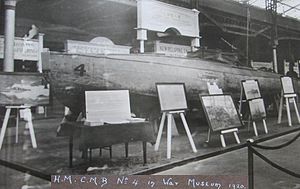- HM Coastal Motor Boat 4
-
HM CMB No 4 in Imperial War Museum London (1920)Career (United Kingdom) Name: HM Coastal Motor Boat 4 Ordered: 1916 Builder: John I. Thornycroft & Company Acquired: 1916 Status: Museum ship General characteristics Type: Coastal Motor Boat Displacement: 5 tons Length: 45 ft (14 m) Beam: 8 ft 6 in (2.59 m) Draft: 2 ft 9 in (0.84 m) Propulsion: 1 shaft Thornycroft V-12 petrol engine which developed 275 bhp (205 kW) Speed: 24.8 kn (45.9 km/h; 28.5 mph) Complement: 3 Armament: 1 x 18-inch torpedo, 4 x .303 Lewis machine guns HM Coastal Motor Boat 4 was one of a large series of small, fast, shallow draught Coastal Motor Boats used during World War I. She was designed by John I. Thornycroft & Company of Hampton, England, ordered in January 1916, built by them and delivered that summer.
CMB 4 was 45 feet (14 m) long and 8 ft 6 in (2.59 m) in the beam. She displaced 5 tons drawing 2 ft 9 in (0.84 m) of water. Power was provided by a 1 shaft Thornycroft V-12 petrol engine which developed 275 bhp (205 kW) and achieved a top speed of 24.8 knots (45.9 km/h). The boat was armed with one 18-inch (460 mm) torpedo and four .303 Lewis machine guns. It carried a crew of 3.
In May 1916, Lt. W.N.T. Beckett MVO DSC took command of the newly built HM Coastal Motor Boat 4. In December 1916 he proceeded to Dunkirk in charge of the 3rd CMB Division and operated on the Belgian coast. Beckett was in command of a Divisional CMB attack on German destroyers at Zeebrugge on 7 April 1917; as a result one was sunk and one very seriously damaged. For these actions Beckett was mentioned in Despatches and was awarded the Distinguished Service Cross (DSC).[1]
The boat, under the command of Lt. Augustus Agar, V.C., was made famous by his part in the British operations in the Baltic Sea against the Bolsheviks in 1919 where she operated with her sister ships in activities such as the raid on Kronstadt.[2]
After the action the boat was returned to the United Kingdom where it was on display first at the Imperial War Museum in London and then at the Vosper works on Platt’s Eyot (island) on the River Thames near Kingston for many years with a Victoria Cross painted on the side until the Vosper works there closed. It was then restored and is now on display with details of the action but with the painted VC removed at the Imperial War Museum’s out-station in Duxford near Cambridge. Agar’s VC is held by the War Museum in London.
The boat was inscribed on the National Register of Historic Vessels in May 1996, becoming part of the National Historic Fleet.[3]
See also
Notes
References
- Commander GL Lowis (1957). Fabulous Admirals, and some naval fragments. London: Putnam & Co..
- Commodore Augustus Agar (1959). Footprints in the Sea. London: Evans Brothers.
Categories:- Torpedo boats of the Royal Navy
- Ships preserved in museums
- National Register of Historic Vessels
- Collection of the Imperial War Museum
Wikimedia Foundation. 2010.

